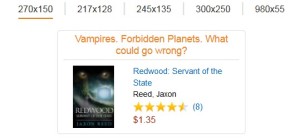Facebook has been successful for me, and from what I have read many other authors enjoy the benefits of advertising there, too. It’s got at least two things going for it, in my opinion. First, it can be relatively cheap. You can set up a daily budget of $5 or $10, and get clicks to your books for a few cents each. Second, Facebook provides a wealth of options when setting up ads, offering to send them to users in very detailed demographics then showing the results from those demographics.
Besides running ads, Facebook also offers options to boost specific posts, making sure more people read it and achieve different objectives such as clicking on your book’s page or your webpage, gaining more “likes” for your Facebook page, etc. Here’s the list of ad campaign objectives available:
- Boost your posts
- Promote your Page
- Send people to your website
- Increase conversions on your website
- Get installs of your app
- Increase engagement in your app
- Reach people near your business
- Raise attendance at your event
- Get people to claim your offer
- Get video views
- Collect leads for your business
All told, ads on Facebook are well worth looking into. There are several tutorials online that go into much better details about how to be effective with Facebook ads, and quite a few blog posts like this one that are worth your time.
One of the most well known set of tutorials is by Mark Dawson. At the very least, check out his free offerings.
